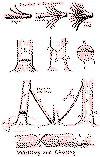by Ernest Thompson Seton
The hatchet has long been the emblem of George Washington, in allusion to the incident of the cherry tree. So also the axe has become an emblem of Abraham Lincoln, the backwoodsman, the rail-splitter, the typical American, who used the axe to carve his home out of the wilderness.
I think that the axe might well be the emblem of America, for it was composed originally of the finest metal that Europe could supply, combined with a handle of the finest, toughest stuff that America could grow; and thus became the best weapon ever wielded by man for subduing the wilderness.
Most of the instructions for use of the hatchet apply equally to the axe; but the axe chiefly is used for cutting down trees and cutting up logs.
To cut down a large tree with an axe, first clear a space around you have firm footing and no limbs are left to catch the axe as it swings. Now begin by cutting the notch A (see illustration) at a convenient height, on the side to which you would throw the tree.
Then split out the big chips B A by strokes at B. Continue the operation until you reach C D. Then stop and cut in the notch E. Resume cutting at C D until the tree falls.
The notch E is never made on the level with D or lower, because then the butt of the tree might shoot backward as the tree falls and kill the woodsman; also, the upright part left standing between E and D prevents the tree falling the wrong way. When it matters little which way the tree goes, the notch is made much lower.
If the tree leans much the wrong way, you can push it over by guide or spring poles. Thus the tree F is leaning to the east, but a strong brace planted at G will make it fall to the south, if you cut the tree chiefly on the south side and leave the last uncut fibers of wood to run east and west, so they act as a hinge.
This hinge is very important at times. In the section H the tree may be inclined to fall toward I, but it is easiest to bend the hinge at right angles to its main length so the angle of the hinge will throw it toward J, if there is no wind and the tree does not lean too much.
Another well-known device is the spring pole. To make sure of the tree K falling toward L, put in a spring pole M, as long and as heavy as you can manage, force it in and have it bent down so that it is pushing against the tree. In some cases, several of these poles are put in. Two are, of course, twice as powerful as one, and when the tree is cut at the L side, the poles push it that way.
These were very familiar woodsman's tricks in my young days, but they are now largely displaced by the saw. The plan being to notch the tree at N, then saw it in at O until large iron wedges day be driven in behind the saw as it sinks into the trunk, and the tree is inevitably thrown toward N, usually in a line at right angles to the cut of the saw.
A clever woodsman can throw a tree so exactly where he wants it that he can make it drive a given stake.
A good axeman can fell a six-inch tree in a minute.
When one is cutting a sapling, it helps greatly if the tree be bent over, then one blow of the axe on the bulge of the bend will usually cut it off, whereas a dozen might be needed if the tree were not pulled over first.
To cut a large log on the ground, the axeman stands on it and cuts between his wide-spread feet; cutting half through each side and keeping the kerfs or cuts plumb, P Q (see illustration). If it were cut through entirely from one side as at R, the labor would be double, because fully twice as much wood must then be removed.
For a small log, it is easier to stand on the ground and cut more nearly on the upper side till halfway through, then roll the log half over and make the other cut.
